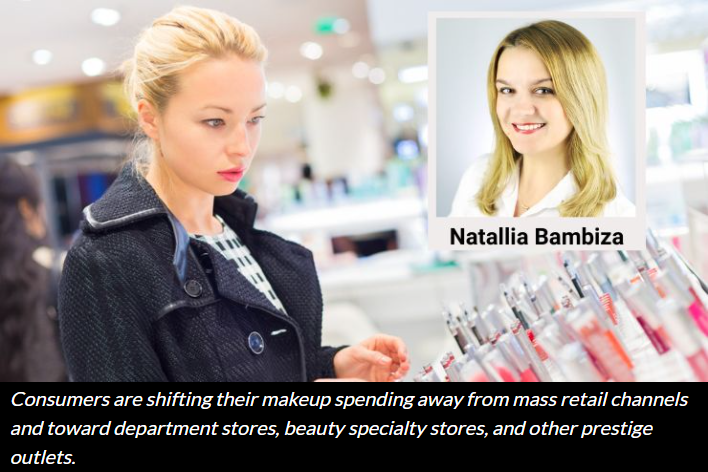
2023-06-13 11:38:18
How the ‘Treat’ Mindset Influences Beauty
2023-06-13 11:38:18
Consumers looking for an emotional pick-me-up are impacting sales in the cosmetics aisle.

Natallia Bambiza, Beauty industry analyst, Circana05.31.23
One of my New Year’s resolutions this year was to limit my makeup purchases to products I needed to replenish. I am using the past tense here because, nearly halfway through the year, I have – as I expected – failed at this goal. Instead, I have found myself browsing beauty aisles many times over the past few months in search of an emotional pick-me-up – something that I wanted, rather than needed, to have. And I am not alone.
Over the past year, the world has been living through economic challenges and inflationary pressures. Higher prices for groceries and other essential items, have forced consumers to reconsider their budgets. To manage higher food costs, more than half of women in the U.S. shop at food stores that offer lower prices, and over 40% buy more store brand or private label foods and beverages, according to Circana’s February Omnibus survey results.
Within the makeup industry, however, we are actually seeing the opposite.
This growth could indicate a consumer desire to treat themselves with a non-essential, yet affordable, prestige-beauty luxury. We observed this phenomenon in 2022 and it continues to prevail in 2023.
This “treat” mindset ties into the “Lipstick Index,” which reveals that lipstick sales are inversely related to the economic state of the country. While cosmetics other than lipstick can be part of this phenomenon, lip products do seem to best meet this criterion. Lipstick and lip gloss are more likely than any other makeup products to be purchased on impulse, according to Circana’s Makeup Consumer Report. Over 40% of lipstick and lip gloss users said that their most recent purchase of a lip product was an impulse one.
The “treat” mindset becomes more evident when we compare how lip makeup sales are faring in the mass market to prestige channels. While lip was the fastest-growing makeup segment in both markets in Q1, it grew more than 1.5 times faster in prestige than in mass – and the more expensive designer brands grew even faster.
Whether it’s a mood-booster, a form of escapism, or a means of self-expression, beauty products hold a special place in consumers’ hearts. Contributing to our emotional wellbeing is a big reason the beauty industry has been so resilient during shaky times. Now that I think about it, perhaps I am not failing at my New Year’s resolution after all; maybe, through this emotional investment, I am actually giving myself exactly what I need.
About the Author
Natallia Bambiza is Beauty industry analyst, Circana (formerly IRI and The NPD Group). Circana is the leading advisor on the complexity of consumer behavior. Find more Circana insights here.
Over the past year, the world has been living through economic challenges and inflationary pressures. Higher prices for groceries and other essential items, have forced consumers to reconsider their budgets. To manage higher food costs, more than half of women in the U.S. shop at food stores that offer lower prices, and over 40% buy more store brand or private label foods and beverages, according to Circana’s February Omnibus survey results.
Within the makeup industry, however, we are actually seeing the opposite.
Consumers Shift Toward Prestige Outlets
Consumers are shifting their makeup spending away from mass retail channels and toward department stores, beauty specialty stores, and other prestige outlets that carry products with higher-price points. In fact, prestige makeup unit sales share increased by 3 points in the first quarter (Q1) of 2023 versus the same period last year.This growth could indicate a consumer desire to treat themselves with a non-essential, yet affordable, prestige-beauty luxury. We observed this phenomenon in 2022 and it continues to prevail in 2023.
This “treat” mindset ties into the “Lipstick Index,” which reveals that lipstick sales are inversely related to the economic state of the country. While cosmetics other than lipstick can be part of this phenomenon, lip products do seem to best meet this criterion. Lipstick and lip gloss are more likely than any other makeup products to be purchased on impulse, according to Circana’s Makeup Consumer Report. Over 40% of lipstick and lip gloss users said that their most recent purchase of a lip product was an impulse one.
The “treat” mindset becomes more evident when we compare how lip makeup sales are faring in the mass market to prestige channels. While lip was the fastest-growing makeup segment in both markets in Q1, it grew more than 1.5 times faster in prestige than in mass – and the more expensive designer brands grew even faster.
Whether it’s a mood-booster, a form of escapism, or a means of self-expression, beauty products hold a special place in consumers’ hearts. Contributing to our emotional wellbeing is a big reason the beauty industry has been so resilient during shaky times. Now that I think about it, perhaps I am not failing at my New Year’s resolution after all; maybe, through this emotional investment, I am actually giving myself exactly what I need.
About the Author
Natallia Bambiza is Beauty industry analyst, Circana (formerly IRI and The NPD Group). Circana is the leading advisor on the complexity of consumer behavior. Find more Circana insights here.
LinkedIn




